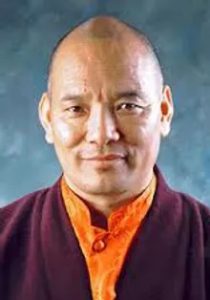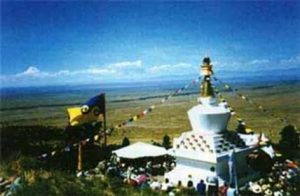Became a Lama
In 1959, Lama Tashi’s father moved his family to Bhutan. During the following eight years, he studied with his father. In 1965 Lama received the novice vows from His Holiness 16th Karmapa during his Holiness’s visit to Bhutan. He received Rinchen Terzod empowerments from Dilgo Khyentse Rinpoche, and many other Nyingma teachings from Dudjom Rinpoche, Dzogchen Rinpoche, Thomb Tulku, and Samdrup Tulku. In 1970 he spent three months in Kalu Rinpoche’s monastery in Darjeeling, India, to receive as many teachings as possible to prepare him for a three-year retreat. During a visit to the Rumtek monastery in Sikkim, His Holiness the 16th Karmapa advised Lama to stay and study in Rumtek before beginning his retreat. Lama stayed at Rumtek for the next 18 years. During this time, HH Drikung Kjbgon asked the Karmapa for teachings of the Six Yoga of Naropa and of Milarepa. When Lama learned that, he asked the Karmapa for permission to participate and his wish was granted.
From that time onwards, he has received many other teachings from the Karmapa. He also received teachings on major texts from Thrangu Rinpoche, Salje Rinpoche, Jamgon Rinpoche, and Khenpo Tsultrim Gyamtso Rinpoche, from whom he had already received a six-month Ngondro teaching. He studied ritual procedures and music, the making of tormas, and, from Tenga Rinpoche, the making of mandalas.
After teaching in the Shedra of Rumtek for three years, Lama Tashi asked permission to enter a three-year retreat. When the principal of the Shedra asked him why he wanted to go on retreat, Lama Tashi answered that, since life is impermanent, he wanted to complete a retreat before his life ends. In 1982, Lama Tashi began his three-year retreat under the “Kagyu retreat master” Bokar Rinpoche. After completing the three-year retreat, he was so inspired that he wanted to remain in retreat for the rest of his life. Instead, he entered a one-year Kalachakra retreat under Bokar Rinpoche in Mirik in Darjeeling, India. Under Bokar Rinpoche’s guidance, he also studied the building of stupas and received the necessary transmissions.
 Lama Tashi Dondup
Lama Tashi Dondup







